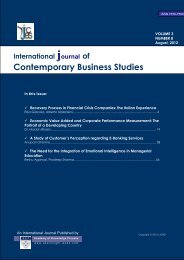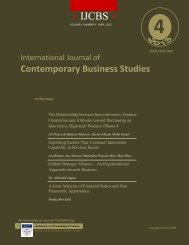Contemporary Business Studies - Academy of Knowledge Process ...
Contemporary Business Studies - Academy of Knowledge Process ...
Contemporary Business Studies - Academy of Knowledge Process ...
You also want an ePaper? Increase the reach of your titles
YUMPU automatically turns print PDFs into web optimized ePapers that Google loves.
International Journal <strong>of</strong> <strong>Contemporary</strong> <strong>Business</strong> <strong>Studies</strong>Vol: 4, No: 2. February, 2013 ISSN 2156-7506Available online at http://www.akpinsight.webs.comemployers to favour graduates with international experience as theywere perceived to have good benefitsand outcomes such as networkingpotential, experiential learning opportunity, additional languageacquisition,and the development <strong>of</strong> s<strong>of</strong>t skills. Working experience is a good example <strong>of</strong>the significance<strong>of</strong> human capital in the role <strong>of</strong> seeking employment as it isone way for graduates to demonstrate what keyemployability skills they haveacquired by providing this evidence <strong>of</strong> work-related or experientiallearning(as cited in Crossman and Clarke, 2009).Lastly, according to a study by Bernstein (1976), graduates with practical experience such as workingexperiences have positive changes in feelings <strong>of</strong> personal and social efficacy, also resulting in showing agreater sense <strong>of</strong> responsibility and career development which eventually leads toward high employability(as cited in Muhamad, Yahya, Shahimi, and Mahzan, 2009).2.8 Social CapitalThe concept <strong>of</strong> social capital is currently receiving a lot <strong>of</strong> attention fromdevelopment agencies andresearch institutions. Falk and Kilpatrick (1999) argue that the accumulation <strong>of</strong> social capital is theoutcome <strong>of</strong> the process <strong>of</strong> learning interactions. Learning interactions require a learning event (an actualoccasion) and occur in a contextual dimension (the broad, socio-cultural and political frame <strong>of</strong> reference).A precondition to building social capital is the existence <strong>of</strong> a sufficient quantity and quality <strong>of</strong> learninginteractions. For example Falk and Kilpatrick suggest that quality learning interactions includes anhistorical context, external interactions, reciprocity, trust, shared norms and values.The planning and implementation <strong>of</strong> community projects may be one such learning interaction. Uph<strong>of</strong>f(1999) distinguishes between structural and cognitive social capital. Structural social capital involvesvarious forms <strong>of</strong> social organization, including roles, rules, precedents and procedures as well as a variety<strong>of</strong> networks that contribute to cooperation. Cognitive social capital includes norms, values, attitudes andbeliefs. Structural and cognitive social capital is complimentary: structures help translate norms andbeliefs into well coordinated goal-orientated behaviour.Other authors (Sabel, 1994) argue that social capital builds up as a result <strong>of</strong> all actors committingthemselves to ongoing negotiations based on shared understanding <strong>of</strong> common goals. Hechter (1987)suggest a multistage process for building group solidarity. Having joined together members must deviserules and procedures, which get institutionalized over time. Internalizing rules and procedures, membersmoderate their behaviour so that these correspond to the expectations others have. This build up <strong>of</strong> socialcapital <strong>of</strong> formal rules and mutual expectations facilitates extending group activities into previouslyunexplored areas.3.0 PROPOSED THEORETICAL FRAMEWORK3.1 Fugate, Kinicki and Ashforth (2004)Fugate et al. (2004) provide not only the conceptual foundation for the construct <strong>of</strong> employability but alsoprovides the conceptual glue that integrates the component dimensions <strong>of</strong> employability (i.e. careeridentity, personal adaptability and social and human capital). Fugate et al. (2004) argued thatemployability captures the aspects <strong>of</strong> each <strong>of</strong> the three dimensions that facilitate the identifications andrealization <strong>of</strong> career opportunities within and between organizations. Please refer to figure 3.1 below.2013©<strong>Academy</strong> <strong>of</strong> <strong>Knowledge</strong> <strong>Process</strong>11
















